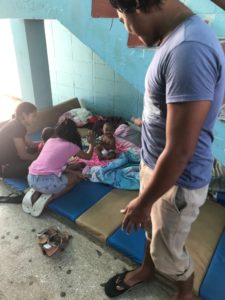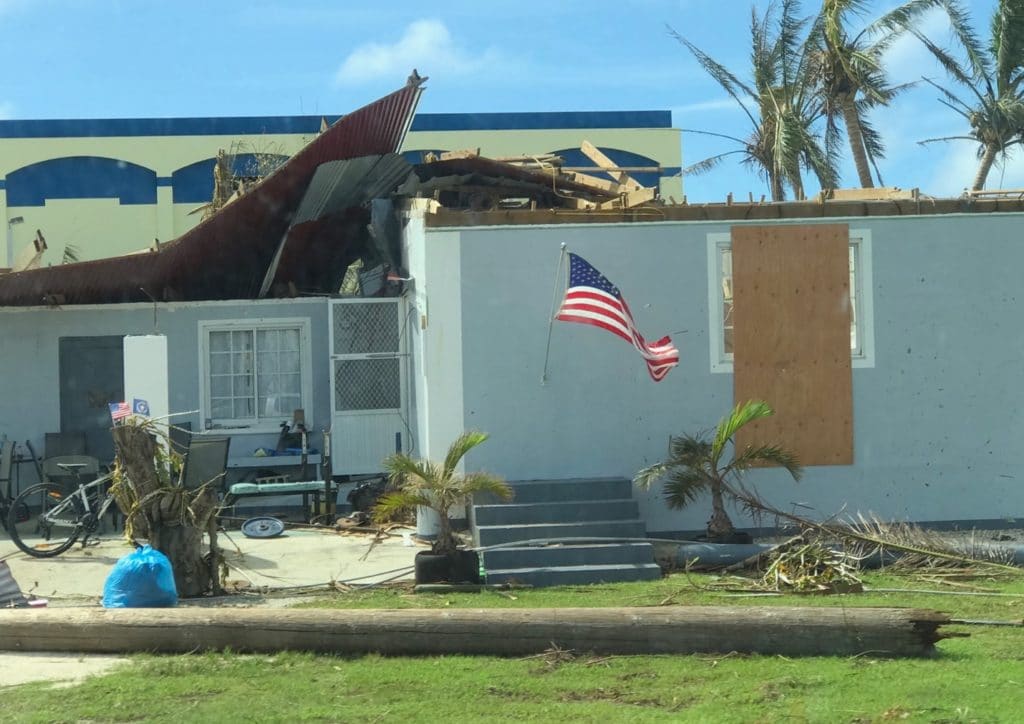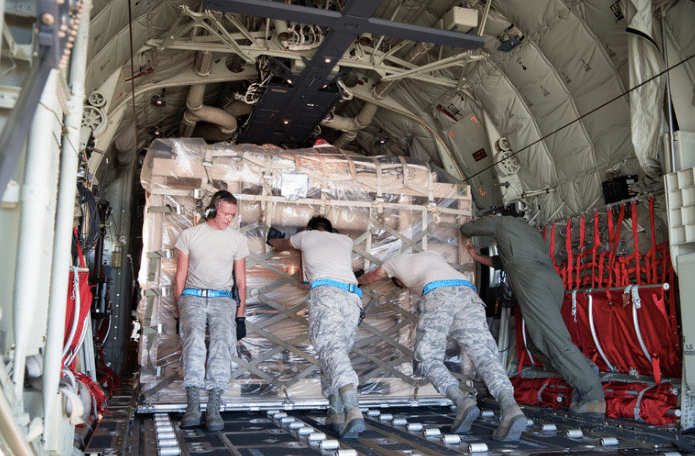Hafa Adai (Hello) from Saipan.
It’s been 15 days since Super Typhoon Yutu sprung up out of the Pacific Ocean, and 12 days since the winds roared across the islands of Tinian and Saipan at speeds of up to 185 mph and gusts up to 235 mph. The residents of the Commonwealth of the Northern Mariana Islands (CNMI) are working to develop their new normal in a place without running water, power and often without a solid roof over their heads.
The stories you hear from residents are harrowing. Homes were destroyed around them and cars were picked up and thrown. The storm was truly a monster. This is what typical roof damage on a house looks like here:
Many Homes Don’t Have Power
Electricity is starting to be restored, but many homes still don’t have power because of their condition. There are 900 power poles to replace on Saipan and 2,000 on Tinian. A difficult task when you realize that a lot of the poles are coming from Washington State.
Shelters Conditions Are Difficult
We have about 900 people who are still in shelters, but that is just a fraction of those affected. Sheltering here on the islands is different than what we normally see in the continental United States. We are 12 days in and the fire department water tankers are supplying water, but there are only three tankers and shelters are running out of water just hours after it’s provided. A lot of the shelters don’t have air conditioning and are running on generators. But even in these conditions, the Red Cross has been providing shelter residents with three meals a day and will continue to do as long as there is a need.
We’re Working with Partners Around the Clock
We are working to move to a better congregate sheltering system, but the success of these shelters depends on reliable  water and power. We are working together with the Public School System (PSS) that is leading sheltering efforts, the Government of CNMI, the Department of Community and Cultural Affairs, FEMA, and more. PSS has dedicated three schools to be congregate shelters. The school system also has conex containers that it is using to hold furniture and schools supplies in (with support from the Department of Corrections and the Department of Defense) to free up every classroom and common space for sheltering. The Red Cross is supporting the PSS in this effort with our subject matter expertise, workforce and supplies. This is going to require moving people from the south side of the island to the north. Thankfully, the Commonwealth Transit Authority has set up a bussing plan that travels to the villages every two hours.
water and power. We are working together with the Public School System (PSS) that is leading sheltering efforts, the Government of CNMI, the Department of Community and Cultural Affairs, FEMA, and more. PSS has dedicated three schools to be congregate shelters. The school system also has conex containers that it is using to hold furniture and schools supplies in (with support from the Department of Corrections and the Department of Defense) to free up every classroom and common space for sheltering. The Red Cross is supporting the PSS in this effort with our subject matter expertise, workforce and supplies. This is going to require moving people from the south side of the island to the north. Thankfully, the Commonwealth Transit Authority has set up a bussing plan that travels to the villages every two hours.
Living Conditions Outside of Shelters
A big concern is the people living outside of shelters. Many are choosing to stay in severely damaged or destroyed homes. As I mentioned earlier, most homes do not have running water and even when electricity is restored to the poles, it will not be restored to homes. Some families are congregating in homes that don’t have as much damage and eating rations.
Delivering Water Where it is Needed
Water is also a big concern. Many people either lost their cars, are not able to carry five jugs of water or are afraid to leave their homes to go to a communal area to get water. Service members from Joint Region Marianas, a military installation here, have been moving water from Anderson Air Force Base to Saipan and Tinian. On Saturday, we partnered with the Department of Defense to deliver drinking water to the villages.
The federal government and CNMI government are also working to set up water bladders with water from wells and the USS Ashland, a ship that desalinates water while traveling from Guam to Saipan. The Red Cross ordered water purification buckets right after the storm that will be delivered to the islands and distributed.
The Red Cross Will Be There Every Step of the Way
Our own Red Cross chapter building here on Saipan is running out of water (we are also on water delivery). The building is an old WWII Bunker that suffered damage during the storm. Our generator is chugging along, but we often don’t have enough fuel for it.
Although there’s a long road ahead, I have hope. And I know that the Red Cross will be there every step of the way to help those affected by the storm.


